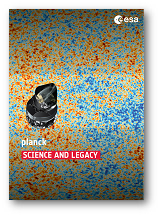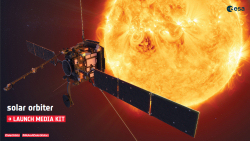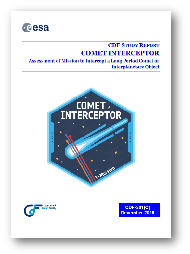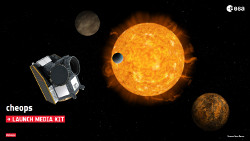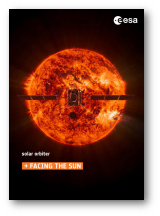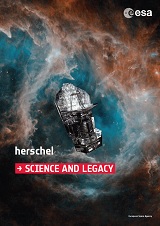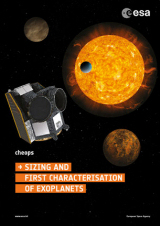ESA Science & Technology - Publication Archive
Publication archive
Publication archive
Reference: ESA-SPI-EST-MIS-RP-001
SPICA (SPace Infrared telescope for Cosmology and Astrophysics) is a far IR telescope to study and answer fundamental astrophysical questions ranging from the formation and evolution of galaxies to the physics of star formation in dusty environments, including the role of magnetic fields, and the origin of planetary systems.
The SPICA mission was conceived as a cooperation between ESA and JAXA and it was initially selected as a candidate for the Cosmic Vision M5 mission together with THESEUS and EnVision. In the course of Phase A, it appeared that, although technical feasibility could be demonstrated, SPICA cost at completion was exceeding the boundaries of an M-class mission. Therefore, ESA, JAXA and SRON jointly decided to withdraw the mission from the M5 selection.
However, the Phase A was completed. The technical outcome is documented in the following report which may be used as guidance and reference for future studies.
Reference: ESA/SCI(2021)2
This is the Assessment Study Report (also known as the Yellow Book) for THESEUS (Transient High-Energy Sky and Early Universe Surveyor) - a candidate mission for the M5 launch opportunity in Cosmic Vision.
THESEUS is designed to fully exploit the unique and breakthrough potentialities of Gamma-Ray Bursts for investigating the Early Universe and advancing multi-messenger astrophysics, while simultaneously vastly increasing the discovery space of high energy transient phenomena over the entirety of cosmic history.
Reference: ESA/SCI(2021)1
This is the Assessment Study Report (also known as the Yellow Book) for EnVision - a candidate mission for the M5 launch opportunity in Cosmic Vision.
EnVision is a Venus orbiter mission that will determine the nature and current state of Venus' geological evolution and its relationship with the atmosphere, to understand how and why Venus and Earth evolved so differently.
Reference: ESA/SCI(2020)1
This definition study report, or Red Book, presents a summary of the very large body of work that has been undertaken on the Ariel mission over the 30-month period of the Ariel definition phase.
Ariel, the Atmospheric Remote-sensing Infrared Exoplanet Large-survey, is the fourth medium-class mission in ESA's Cosmic Vision programme. It will address the fundamental questions on what exoplanets are made of and how planetary systems form and evolve by investigating the atmospheres of many hundreds of diverse planets orbiting different types of stars.
This brochure summarises the Planck mission and gives a glimpse of its main achievements.
Planck set out to map the very faint anisotropies in the Cosmic Microwave Background to an angular resolution and sensitivity that would exhaust all the cosmological information that can be extracted from them. In addition Planck has mapped the much fainter polarised fraction of these same anisotropies. The resulting maps of the sky contain traces from the very earliest times, revealing the recipe that embodies our most precise understanding of the structure, composition, and evolution of the Universe that we inhabit.
Contents:
- Foreword
- Making sense of the Universe
- The early Universe
- The Planck mission
- An almost perfect Universe
- Planck's view of the Cosmic Microwave Background
- The big and the small
- Structure formation and gravitational lensing
- The first stars
- Mapping foreground emission from the Milky Way
- A lasting legacy
This document presents the activities in the Science Core Technology Programme (CTP) and in the Technology Development Element (TDE, replacing the TRP) of the Discovery, Preparation & Technology Development Basic Activities supporting the implementation of ESA's Science Programme. The national initiatives activities of relevance to the Science programme are provided for information. Activities funded through the Industrial Policy Task Forces (IPTFs) and of relevance to the Science Programme are also provided for information.
This document is provided for information only and is subject to future updates.
Download this interactive media kit to learn more about the launch of Solar Orbiter in February 2020 and the science goals of the mission. Solar Orbiter will perform unprecedented close-up observations of the Sun and from high-latitudes, providing the first images of the uncharted polar regions of the Sun, and investigating the Sun-Earth connection.
Contents:
- Introduction
- How to use this media kit
- Event programme
- How to follow the launch online
- What’s new
- Answering the big questions
- Operating in extreme environments
- Instruments
- Launch and deployment sequence
- Journey around the Sun
- Extreme exploration with Solar Orbiter and Parker Solar Probe
- Anatomy of the Sun
- Missions studying the Sun
- Meet the Sun
- Solar Orbiter team
- Selected multimedia
- Media services
To open the pdf file (16 MB) click on the image or on the link to publication below.
Document reference: CDF-201(C)
In July 2018, ESA issued to the science community a Call for a Fast (F) mission opportunity in ESA's Science Programme. After a two-phase review process the Comet Interceptor mission was selected in June 2019 for going into the study phase, starting with a Concurrent Design Facility (CDF) mission assessment study.
The Comet Interceptor spacecraft will be launched in 2028 towards the Sun-Earth second Lagrange point, L2, on-board an Ariane 6.2 as co-passenger to the Ariel mission. The mission aims to intercept in a fly-by scenario a Long Period Comet (LPC), with Dynamically New Comets (DNCs) representing the highest priority type of LPC, or an interstellar body passing through our Solar System. The mission includes three elements, one main spacecraft (ESA) and two probes (one ESA and one JAXA) carried as payloads until the fly-by, at which point they are released to gather multi-point observations of the comet and its coma.
This second Comet Interceptor study carries on from the first Comet Interceptor study performed in the ESA CDF in early 2019. The second study was carried out by an interdisciplinary team of experts from ESA with the participation of JAXA and the mission proposer team in six sessions and two extra delta sessions, between October and December 2019.
Download this interactive media kit to learn more about the launch of CHEOPS on 17 December 2019 and the science goals of the mission. CHEOPS, the CHaracterising ExOPlanet Satellite, is ESA's first mission dedicated to the study of exoplanets. It will observe bright stars that are already known to host planets, measuring minuscule brightness changes due to the planet's transit across the star's disc.
Update 20 Dec: A new version of the media kit was released containing the updated launch date, 18 December 2019, on p3 and p18. A typo was also corrected on p17.
Contents:
- Introduction
- Event programme
- Key messages
- CHEOPS science themes
- CHEOPS: an exoplanet follow-up mission
- Exoplanet detection methods
- Exoplanets discoveries
- Examples of planetary systems
- Characterising exoplanets with CHEOPS
- CHEOPS observing programmes
- What are exoplanets made of?
- Open questions: How do planets form?
- Open questions: How do planets evolve?
- High photometric stability and precision
- Where is CHEOPS?
- Launch details and timeline
- CHEOPS team and consortium
- Selected images
- Selected videos
- Media services
To download the pdf file (25 MB) click on the image or on the link to publication below.
Solar Orbiter is a mission dedicated to solar and heliospheric physics. It will address big questions in Solar System science to help us understand how the Sun creates and controls the heliosphere, the giant bubble of plasma that surrounds the whole Solar System and influences Earth and the other planets within it. The spacecraft will provide close-up, high-latitude observations of the Sun to gain new information about the solar wind, the heliospheric magnetic field, solar energetic particles, transient interplanetary disturbances and the Sun's magnetic field.
Contents:
- Living with a star
- Exploring our Sun
- Anatomy of our Sun
- Preparing for extreme environments
- How Solar Orbiter will study the Sun
- Launching and operating Solar Orbiter
- Teamwork with Parker Solar Probe
- An international enterprise
Document reference: ESA-SCI-F-ESTEC-RP-2019-001
The EPIG (ESA Probe for Investigation of the Giants) CDF study explored the feasibility of a European "stand-alone" mission to the Ice Giants (or Saturn as back-up). It corresponds to an ESA internal assessment of the capabilities to use only European technology to explore the outer planets.
The study was carried out by an interdisciplinary team of experts from ESA in eight sessions, starting with a kick-off on 28 March 2019 and ending with an Internal Final Presentation on 9 May 2019. This is a summary report of the EPIG CDF study. The full CDF study report will be made available at a later date.
This brochure summarises the Herschel mission and its science achievements to date, capturing the basis for the science yet to come and its enduring legacy.
The European Space Agency's Herschel Space Observatory flew the largest single mirror ever built for a space telescope. At 3.5-metres in diameter the mirror collected long-wavelength radiation from some of the coldest and most distant objects in the Universe. In addition, Herschel was the only space observatory to cover a spectral range from the far infrared to sub-millimetre.
The Herschel mission leaves behind a lasting legacy in the form of a treasure trove of data, thousands of scientific papers, and a new generation of astronomers whose professional lives have been formed by working on this remarkable endeavour.
Contents:
- Foreword
- The other half of the light
- Tools of the trade
- The Herschel mission
- Gathering the light
- The infrared Universe
- Origins
- Engines of star formation
- From dust to planets
- The water trail
- An international enterprise
- A lasting legacy
CHEOPS is ESA's CHaracterising ExOPlanet Satellite. It is the first mission dedicated to studying bright, nearby stars that are already known to host exoplanets, in order to make high-precision observations of the planet's size as it passes in front of its host star. It will focus on planets in the super-Earth to Neptune size range, with its data enabling the bulk density of the planets to be derived – a first-step characterisation towards understanding these alien worlds.
Contents
- Why exoplanets
- Enter CHEOPS
- How CHEOPS will characterise exoplanets
- Designing a planet watcher
- A European collaboration
- Welcome onboard!
The scale of groundwater upwelling on Mars, as well as its relation to sedimentary systems, remains an ongoing debate. Several deep craters (basins) in the northern equatorial regions show compelling signs that large amounts of water once existed on Mars at a planet-wide scale. The presence of water-formed features, including fluvial Gilbert and sapping deltas fed by sapping valleys, constitute strong evidence of groundwater upwelling resulting in long term standing bodies of water inside the basins. Terrestrial field evidence shows that sapping valleys can occur in basalt bedrock and not only in unconsolidated sediments. A hypothesis that considers the elevation differences between the observed morphologies and the assumed basal groundwater level is presented and described as the "dike-confined water" model, already present on Earth and introduced for the first time in the Martian geological literature. Only the deepest basins considered in this study, those with bases deeper than −4000 m in elevation below the Mars datum, intercepted the water-saturated zone and exhibit evidence of groundwater fluctuations. The discovery of these groundwater discharge sites on a planet-wide scale strongly suggests a link between the putative Martian ocean and various configurations of sedimentary deposits that were formed as a result of groundwater fluctuations during the Hesperian period. This newly recognized evidence of water-formed features significantly increases the chance that biosignatures could be buried in the sediment. These deep basins (groundwater-fed lakes) will be of interest to future exploration missions as they might provide evidence of geological conditions suitable for life.

